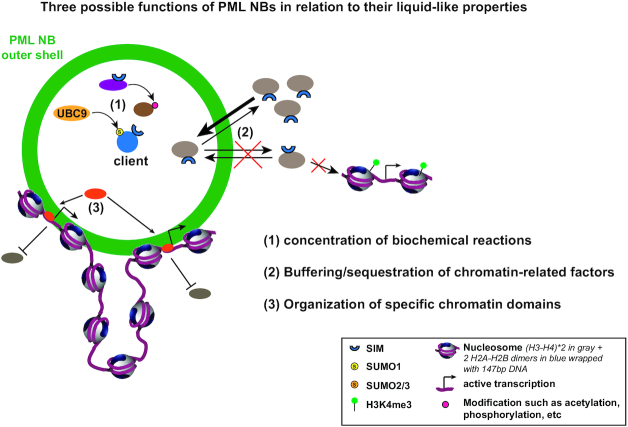Figure 2.
Three possible functions of PML NBs in relation to their liquid-like properties. Liquid properties are advantageous for the cells by providing the ability of fast and easy rearrangements of macromolecules. Yet, the separation of the “liquid" nucleoplasm in several membrane-less condensates including PML NBs is essential to allow the formation of small reaction volumes with a different composition from the outside. Description of PML NBs as biomolecular condensates can illuminate the understanding of their function. We can envisage three important functions which may explain their roles in chromatin dynamics: (1) PML NBs may concentrate biochemical reactions. The biochemical environment within phase-separated PML NBs is different from the nucleoplasm and could serve to regulate (i) the kinetics of enzymatic reactions or (ii) the specificity of the modifications catalyzed. This is consistent with the described role of PML NBs as sumoylation hotspots, but could also apply for other modifications such as phosphorylation, acetylation, ubiquitination, or protein degradation. An example of the SUMOylation of a given client by UBC9 or of another client modification by a specific enzyme is shown. (2) PML NBs may buffer/sequester proteins via liquid-liquid phase separation of these client proteins. Increase in PML/client concentration may trigger accumulation of a given protein in PML NBs as a means to buffer the amount of the free protein in the nucleoplasm (as observed early for CBP for example). In addition, protein sequestration in PML NBs might affect their known activity as observed for DAXX. (3) PML NBs may help to organize specific nuclear domains, such as chromatin domains. PML NBs are interspersed in the active chromatin compartment and could potentially help to organize this compartment by pulling together genomic loci with similar transcriptional regulation. Of note, these three functions are not mutually exclusive and may serve altogether to regulate chromatin dynamics. Concentration of various factors in PML NBs together with specific genomic loci may help to catalyse specific reactions at given loci, as in the case of the ALT pathway for example (see Figure 3).

